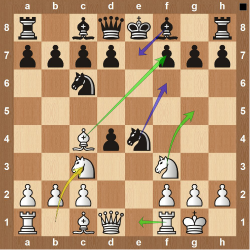
Your opponent won’t always accept your gambits. It’s important to understand how to continue your attack if they do decide to decline. There are many declined lines you might see in the Nakhmanson Gambit.
1.e4 e5
2.Nf3 Nc6
3.Bc4 Nf6
4.d4 exd4
5.O-O Nxe4
6.Nc3
The main thing that white needs to consider when playing the declined lines of the Nakhmanson Gambit is to stay aggressive. If white trades down and doesn’t continue to attack, black will have the upper hand with little risk of losing the game
6…Nd6
This makes sense for black. It keeps the knight that was on e4 safe. It defends the pawn on f7 and keeps the attack going on the c3 square. White now should get the dark square bishop involved into the game with 7. Bg5. Black generally will then play 7…Be7 and after Nxe7 then Qxd4 and white has a very aggressive setup.
6…Nf6
Now white can play 7. Ng5. This puts two attacks on the f7 square with both the knight on g5 and the bishop on c4. This is a common way for white to attack the king side for black. If they try to stop the attack with Ne5, that loses to Re1. If black tries to play Nd5, blocking the bishop, then white can play Qf3 with a strong attack.
6…Be7
Black looks to castle on the king side after 6…Be7 but white should not let that happen. White should play 7. Bxf7+ and after 7…Kxf7 and white will now look to attack the exposed king the rest of the game.
The good news is that even if your opponent declines the Nakhmanson Gambit you still have many aggressive lines that you can take to put your opponent in some very difficult positions.